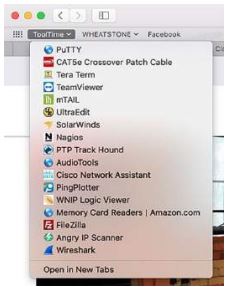Digital Tools You Should Find Useful

[February 2018] One of the nice things about the Internet is the abundance of applications, scripts, and other tools that can help you do all kinds of diagnostics and fixes. The problem is finding the right ones for your needs.
This time, Wheatstone Tech Guys Dick Webb and Robert Ferguson (with chime-ins from systems engineers Kelly Parker and Scott Johnson, in order, above) offer a dozen and a half of their favorite digital tools.
These days, an engineer needs more than a multimeter and a couple of Xcelite Greenies to get the job done.
Here are some of our favorite network tools that we suggest you put in your digital toolbox, if you do not have them already. Most of these are free for non-commercial use.
1. A telnet application such as PuTTY.
With a telnet app, you can determine how commands are being received between clients and servers and gather lots of good information about what is going on in your system, especially if used with WheatNetIP’s built-in debugging tools.

Put your tools in a “favorites” folder for easy access
2. A short 4 to 7-foot CAT 5/6 crossover cable
This is most useful for connecting gear directly into a laptop in the event you need to isolate it from the main network for troubleshooting. While you are at it, add a USB-to-serial-port adapter for interfacing to RS232-only gear and a USB-to-RJ45 for troubleshooting the network switch.
In addition, said Parker, “To use the USB connection on most modern Cisco switches you may also want to have the Cisco USB console driver installed. That is a free download from Cisco.com.”
3. Remote Access software
TeamViewer is great for remotely connecting to networks and devices from just about anywhere.
You will need this especially if you support several systems and locations.
4. Something to view text based log files
Options range from Notepad ++ and Gamut Log Viewer to mTail, which Ferguson uses to monitor logs in near real time and to drill down on specific terms he is watching for in the log.
For editing text files, Johnson uses a commercial product called UltraEdit.
”UltraEdit has saved my life many times in the last 20 years. It’s a mature product, actively developed, and can do some amazing things no other text editor can,” he said.
5. SNMP (Simple Network Management Protocol) browser or manager
SNMP software such as SolarWinds or Nagios can be helpful in determining if a particular network port is dropping packets or if a device is heating up. These applications can show you data packets coming in or going out, by the port, and from microphone processors on out to the transmitter.
Not all network devices or IP audio networks have SNMP capability. They need to generate MIB, or Management Information Base, files. For example, the I/O BLADE access units that make up our WheatNet-IP network each have a unique MIB file with hundreds of data points, and each BLADE has a unique object address in the network for SNMP monitoring and alert purposes.
Using SNMP software, you can capture packet counts, uptimes, temperature readings and other critical data for troubleshooting and monitoring network switches, BLADEs, PCs and other devices in the WheatNet-IP audio network.
6. PTP Track Houndor or similar software for analyzing PTP (IEEE 1588) network traffic such as found on an AES67 connection.
“This is useful for troubleshooting PTP master issues when using AES67,” said Parker.
7. Tone generator software
No audio engineering toolkit is complete without this. Our systems engineer Scott Johnson uses AudioTools for iOS devices. “There is nothing handier than an app that can turn your phone into a tone generator, white or pink noise generator, RTA and FFT analyzer,” he said.
This software helps in configuring, managing, and troubleshooting. Go to Cisco Network Assistant to download.
9. Network diagnostic software
PingPlotter will help you to troubleshoot latency, packet loss, and other performance issues.
This allows for detecting and troubleshooting logic issues within the system.
11. A card reader
Get one for each of the types of Flash cards used or one that works with various different cards.
12. FTP file manager
FileZilla not only shuttles files around, but for FTPing changes and options into the Flash memory of a Wheatstone control surface. It is a fast and easy way to convey those changes.
13. Network scanner
Angry IP Scan can also be helpful for getting a quick read on IP addresses and determining which ones are active. (Note: Symantec Endpoint Protection treats Angry IP Scanner as a virus. You will need to add it to the list of acceptable programs.)
14. Network sniffer/analyzer
Wireshark can quickly view messages exchanged between your WheatNet-IP audio network and the automation system.
– – –
The Wheatstone Tech Guys represent decades of experience, both with electronic and computer matters.
If you need help, contact them at: support@wheatstone.com
– – –
Would you like to know when other articles like this are published?
It takes only 30 seconds to add your name to our secure one-time-a-week Newsletter list.
Your address is never given out to anyone else.
– – –
